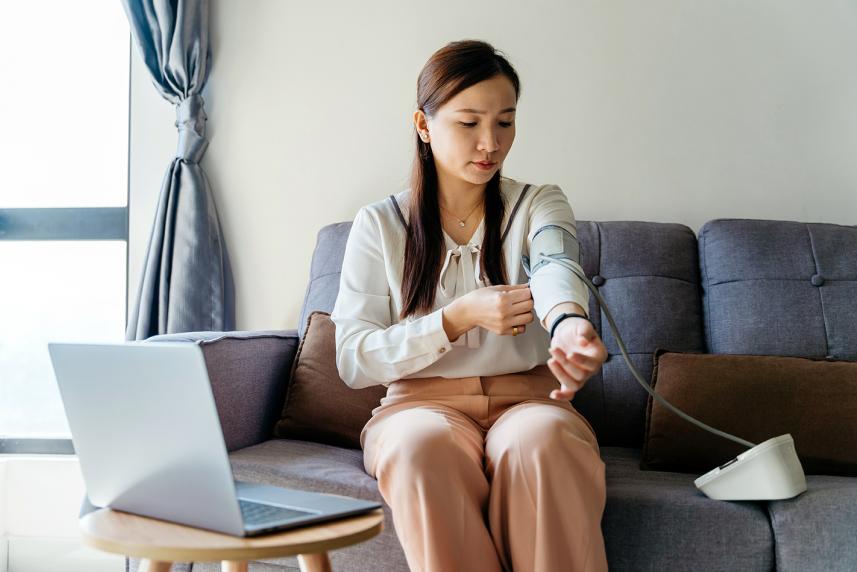
We have more than 60,000 doctors at over 2,000 locations. Our team will help you get the care you need, when and where you need it.

Monitoring your blood pressure and keeping it in a healthy range could help you avoid dementia.
If you’re looking for ways to protect your brain, start with your heart. This is according to new research from Northwestern Memorial Hospital in Chicago.
The study looked at the brain scans of adults at age 30 and then again when they were around 55. Those with high blood pressure in the first test were more likely to show signs of dementia in the second.
The data was presented at the annual conference of the American Stroke Association. It hasn’t yet undergone peer review, but it supports the team’s earlier work.
The researchers published a similar study in the journal Circulation in 2020. They found that high blood pressure in younger adults was linked with worse memory and decision-making skills later in life. One possible reason: High blood pressure strains the brain’s blood vessels. This can damage parts of the brain needed for learning, thinking and remembering.
This link between blood pressure and dementia is a serious problem. Nearly half of American adults have high blood pressure or are on medication for the condition, according to the Centers for Disease Control and Prevention.
If you’re one of them, we may be able to help you save money on medication. Download your free prescription discount card to help you save up to 80% at the pharmacy.
And if you’re wondering what you can do to protect your arteries and brain, we have you covered there, too. But first, it helps to understand the problem.
As blood pressure goes up, the neurons (or nerves) in the brain don’t get the blood they need, says Bruce Mayerson, MD. He specializes in neurology at Catholic Health Physician Partners in Long Island, New York.
What’s more, high blood pressure can lead to small, undetectable strokes. “These strokes can start as young as your 20s, and you might not be aware you're having them,” says Mohamed Teleb, MD. He’s a specialist in endovascular surgery and neurocritical care at Banner – University Medical Center Phoenix.
“You could have these strokes for 20 or 30 years and not know it,” Dr. Teleb adds. (Here’s what to do if you suspect you’ve had a mini stroke.)
These strokes and the elevated blood pressure that leads to them can cause long-term brain damage, says Dr. Teleb. The second-leading cause of dementia (after Alzheimer’s disease) is vascular dementia, according to the U.S. Department of Health and Human Services. Vascular dementia is a decline in thinking skills that occurs when a condition, such as a stroke, reduces blood flow to the brain.
Fortunately, you can help prevent this. It starts by recognizing whether you’re at risk.

We have more than 60,000 doctors at over 2,000 locations. Our team will help you get the care you need, when and where you need it.
You should already be getting your blood pressure checked at least once a year at your annual physical. That’s a great place to start. But if you’re at risk of high blood pressure, one reading per year might not give you the whole picture.
Your blood pressure can change from hour to hour throughout the day, according to the Cleveland Clinic. Some people even experience white-coat syndrome. This is when your blood pressure goes up when you're with a healthcare provider.
To test your blood pressure more often and from the quiet of your own home, you can use a blood pressure cuff. One option: the SmartHeart Blood Pressure Monitor.
Home blood pressure monitors are slightly less precise than the ones in a doctor’s office. But they’re accurate enough to give you useful readings, according to a study published in The Journal of Clinical Hypertension.
The American Heart Association (AHA) recommends monitors with arm-style cuffs. To get a reliable reading, follow these steps:
After testing, you’ll get results with two numbers:
Check your blood pressure once a week, Dr. Teleb advises. If the numbers are 120 to 129 over less than 80, your blood pressure is considered elevated. If your systolic number is higher than 129, or your diastolic number is higher than 80, your blood pressure is high. That means your heart and brain could be at risk.
If your blood pressure is high, you should talk to your doctor. There are several medications that can treat high blood pressure.
Don't forget about lifestyle changes, too. “There is so much that you can do to lower your blood pressure besides taking medication,” says Dr. Teleb. Here’s where to start:
For more brain-health inspiration, check out these 16 little ways to lower your blood pressure. (Some of them are easier than you might think.)
Additional sources
Blood pressure at age 30 predicts cognitive decline later: American Heart Association
Blood pressure and decision-making: Circulation (2020). “Cumulative blood pressure exposure during young adulthood and mobility and cognitive function in midlife”
47% of U.S. adults have high blood pressure: Centers for Disease Control and Prevention
Blood pressure fluctuations: The Cleveland Clinic
White-coat hypertension: The Mayo Clinic
At-home blood pressure cuffs: American Heart Association
Accuracy of home blood pressure cuffs: The Journal of Clinical Hypertension (2020). “The first study comparing a wearable watch-type blood pressure monitor with a conventional ambulatory blood pressure monitor on in-office and out-of-office settings”
Stretching for blood pressure: Journal of Physical Activity and Health (2021). “Stretching is superior to brisk walking for reducing blood pressure in people with high–normal blood pressure or stage I hypertension”
Sleep recommendations for adults: National Sleep Foundation
High blood pressure and salt intake: American Heart Association
© 2022 Optum, Inc. All rights reserved. Do not reproduce, transmit or modify any information or content on this website in any form or by any means without the express written permission of Optum.
The information featured in this site is general in nature. The site provides health information designed to complement your personal health management. It does not provide medical advice or health services and is not meant to replace professional advice or imply coverage of specific clinical services or products. The inclusion of links to other websites does not imply any endorsement of the material on such websites.
Stock photo. Posed by model.